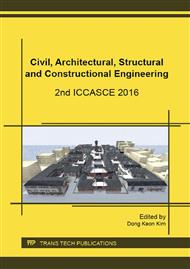p.3
p.10
p.15
p.22
p.29
p.34
p.38
p.44
Numerical Simulation of Rotational Behavior of Bolted Glulam Beam-to-Column Connections with Slotted-In Steel Plates
Abstract:
This paper presents the results of a numerical study on rotational behavior of bolted glulam beam-to-column connections. Since wood often exhibited complex failure behavior under different loading states, a three dimensional anisotropic damage analysis model of wood was initially developed based on continuum damage mechanics theory for progressive failure analysis of wood. The damage model basically consisted of two ingredients: the failure criterion proposed by Sandhaas was chosen to capture the damage onset; three independent damage variables were adopted to control the ductile and brittle damage evolution process of wood. This material model was implemented in a commercial available finite element method based code using a user-material subroutine. Finite element model of bolted connection coupled with the proposed material model was established to further investigate the failure modes and moment resistance of such connections. It was found that the damage evolution progress was very similar to the crack development from experimental tests. By comparing the experimental results and numerical predictions, a fair agreement of the initial stiffness and moment resistance was found with modeling error less than 3%, which implied that the finite element model was suitable to simulate the rotational behavior of such connections. This research could provide the reference for the design of bolted glulam connections in heavy timber structures.
Info:
Periodical:
Pages:
22-28
Citation:
Online since:
November 2016
Authors:
Price:
Сopyright:
© 2017 Trans Tech Publications Ltd. All Rights Reserved
Share:
Citation:


